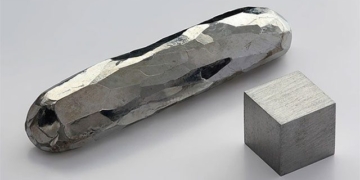Scientists Create a New Material That is Nearly Indestructible and Could Compete with Diamond for the Title of the Hardest Compound on Earth.
Diamond is still recognized as the hardest material in the world. It holds the top position in tools for the most extreme tasks, from saw blades to spacecraft components.
Since the late 1980s, scientists have been seeking to replace diamond mining, which involves mines formed deep within the Earth and is often associated with labor exploitation and environmental damage, with a material known as carbon nitride.
Carbon nitride, formed from carbon and nitrogen, theoretically matches the hardness of diamond. However, a large-scale industrial solution has remained unfeasible for a long time.
An international team of scientists, led by researchers at the Extreme Conditions Science Center at the University of Edinburgh, has made a breakthrough by synthesizing carbon and nitrogen precursors to create carbon nitride, a compound harder than cubic boron nitride, which is currently the second hardest material in the world after diamond. They published their research results in the journal Advanced Materials, as reported by New Atlas on December 14. According to researcher Dominique Laniel from the University of Edinburgh, this material provides a strong impetus to bridge the gap between high-pressure material synthesis and industrial applications.

Diamond is currently the hardest material in the world. (Photo: PA).
Despite scientists recognizing the potential of carbon nitride since the 1980s, including its high thermal resistance, the production of this material tells a different story. In fact, up to now, no reliable studies on the synthesis of carbon nitride have been published.
The research team, consisting of several material experts from the University of Bayreuth in Germany and Linköping University in Sweden, achieved success by subjecting various forms of carbon nitrogen precursors to pressures of 70 – 135 gigapascals (about one million times atmospheric pressure), while heating them to over 1,500 degrees Celsius. They then examined the atomic arrangement through X-ray beams at the European Synchrotron Radiation Facility in France, the Deutsches Elektronen-Synchrotron in Germany, and the Advanced Photon Source in the United States.
The analysis results revealed three synthesized carbon nitride compounds with structures necessary for superhard materials. The researchers were surprised to discover that the trio of compounds retained their superhard characteristics even as they cooled down and returned to surrounding pressure. The team believes this breakthrough could pave the way for numerous applications, including protective coatings for vehicles and spacecraft, efficient cutting tools, and optical sensors.
In addition to hardness, these nearly indestructible carbon nitride compounds also exhibit luminescent, piezoelectric properties, and high energy density, capable of storing large amounts of energy in a small volume.

The new material from carbon nitride is nearly as hard as diamond, with potential applications across various fields.
Carbon nitride cannot completely replace natural diamond. The hardness of a diamond is around 90 gigapascals (GPa), while a block of boron nitride only reaches about 50 to 55 GPa. The new carbon nitride compound achieves around 78 to 86 GPa, depending on the crystal structure. The difference in numbers is not vast, but it is not enough to dethrone diamond.
The samples of the new material created by scientists are only 5×3 micrometers in size. To produce larger samples, larger diamonds and even higher pressures will be needed, making the new superhard carbon nitride extremely expensive.
However, reducing costs will be the goal as this material has advantages over conventional diamonds; it can generate electrical signals—a convenient feature for use in sensors.





















































